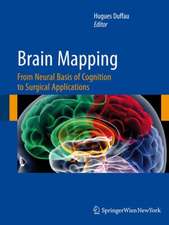Microsurgery for Cerebral Ischemia
Editat de S.J. Peerless, C.W. McCormicken Limba Engleză Paperback – 4 noi 2011
Preț: 387.58 lei
Preț vechi: 407.98 lei
-5% Nou
Puncte Express: 581
Preț estimativ în valută:
74.16€ • 77.43$ • 61.38£
74.16€ • 77.43$ • 61.38£
Carte tipărită la comandă
Livrare economică 05-19 aprilie
Preluare comenzi: 021 569.72.76
Specificații
ISBN-13: 9781461260929
ISBN-10: 1461260922
Pagini: 392
Ilustrații: XVIII, 372 p.
Dimensiuni: 210 x 280 x 21 mm
Greutate: 0.89 kg
Ediția:Softcover reprint of the original 1st ed. 1980
Editura: Springer
Colecția Springer
Locul publicării:New York, NY, United States
ISBN-10: 1461260922
Pagini: 392
Ilustrații: XVIII, 372 p.
Dimensiuni: 210 x 280 x 21 mm
Greutate: 0.89 kg
Ediția:Softcover reprint of the original 1st ed. 1980
Editura: Springer
Colecția Springer
Locul publicării:New York, NY, United States
Public țintă
ResearchCuprins
I. Lectures by Dr. M.E. Raichle (Honored Guest of Symposium).- 1. Role of erythrocyte carbonic anhydrase in oxygen delivery to brain..- 2. Recent developments in the measurement of cerebral hemodynamics and metabolism..- II. Cerebral Ischemia and Infarction.- 3. Serum and CSF brain-specific isoenzyme profiles in experimental cerebral ischemia and infarction..- 4. Free radicals and oxygen during reperfusion..- 5. A new model for chronic reversible cerebral ischemia..- 6. Brain energetics in patients undergoing STA-MCA anastomosis..- III. Cerebral Blood Flow.- 7. Changes in cerebral autoregulation in patients undergoing microanastomosis..- 8. Regional cortical blood flow during cerebrovascular surgery..- 9. The use of STA-MCA bypass in the evaluation of rCBF..- 10. rCBF measurement in patients with STA-MCA shunts..- 11. Cerebral blood flow in superficial temporal artery to middle cerebral artery anastomosis..- 12. Experimental cerebral revascularization studied by 85Kr clearance and fluorescein angiography after 24 hours of permanent occlusion of the middle cerebral artery in dogs..- 13. Regional cerebral perfusion assessed with 81mKr and emission computerized tomography..- 14. The value of noninvasive regional CBF measurements in diagnostic and follow-up studies in cerebral vascular diseases with special regard to EIAB..- IV. Noninvasive Methods of Investigation and EEG Analysis.- 15. Noninvasive management of stroke patients by Doppler sonography and dynamic radionuclide brain scanning..- 16. Noninvasive evaluation of superficial temporal to middle cerebral artery anastomosis..- 17. Intraoperative hemodynamic study by Doppler ultrasonic flowmeter in the extracranial-intracranial arterial bypass..- 18. Ocular pneumoplethysmography in carotid occlusive disease..- 19. Changes in collateral circulation and EEG analysis following extra-intracranial anastomosis..- 20. The emergency STA-MCA bypass evaluated by the induced-functional EEG analysis in acute ischemic stroke..- V. Radiology.- 21. Correlation of noninvasive Doppler and angiographic evaluation of extra-intracranial anastomoses..- 22. STA-MCA anastomosis: Detailed analysis of pre- and postoperative angiography..- 23. Angiography of the external carotid-internal carotid anastomosis (EC-IC)..- 24. Cortical artery pressure: Preoperative and postoperative arteriographic findings in patients with internal carotid artery occlusion..- 25. Angiographic findings and cross-sectional brain perfusion studies after extra- intracranial arterial bypass..- 26. Morphologic and functional correlates in transient cerebral ischemia..- VI. Technical Aspects.- 27. In-situ dissections of brain with emphasis on blood supply at the base of the brain..- 28. Successful adhesive repair of middle cerebral arteriotomy in primates..- 29. A new technique for the end-to-side anastomosis between small arteries..- 30. Safe microclip occlusive force for temporary vascular occlusion..- 31. The influence of adventitial tissue to healing processes following microsurgical interventions on small vessels..- 32. Ultrastructural control of small vessels following microsurgical intervention by tissue adhesion with fibrin..- 33. Comparative evaluation of microvascular arterial graft: Arterial autograft versus human umbilical artery graft..- 34. Patency, blood flow and histologic response in 2- to 3-mm arterial autografts..- 35. Arterial dilatation and augmentation of blood flow in experimental arteriovenous fistulas..- 36. The effect of heparin on the patency rate of autogenous vein grafts inserted into the arterial system of rats..- 37. The quantitative assessment of the effect of antiplatelet drugs on thrombosis in microvascular anastomoses..- 38. Relationship of internal carotid artery stump pressure to STA-MCA bypass function..- 39. Measurement of intracranial arterial pressure in patients undergoing extracranial to intracranial microsurgical anastomosis for cerebrovascular ischemia..- VII. Clinical Aspects.- 40. High cervical carotidopathies..- 41. Extra-intracranial arterial bypass surgery for cerebral ischemia in patients with normal cerebral angiograms..- 42. Revascularization in the acute stage of the MCA occlusion..- 43. Cerebral microvascular surgery in completed stroke..- 44. Extra-intracranial anastomosis operation associated with hyperbaric oxygenation in the treatment of completed stroke..- 45. Extra-intracranial arterial bypass surgery in patients with bilateral internal carotid artery occlusions..- 46. The surgical management of bilateral carotid artery occlusive disease..- 47. Indications for surgery in patients with several cerebrovascular lesions..- 48. Further experience with occipital artery-caudal loop-PICA anastomosis for vertebrobasilar insufficiency..- 49. New approaches in cerebral revascularization..- 50. Failure of EC-IC bypass to alter ischemia..- 51. Hemorrhagic infarction after microsurgical cerebral revascularization..- 52. Extracranial-intracranial anastomosis in cerebrovascular disease..- 53. Results in 51 patients with EC-IC bypass: Technical and clinical considerations..- 54. Microneurosurgical arterial bypass for cerebral ischemia: The San Francisco experience..- 55. STA-MCA anastomosis: further analysis of long-term results—A neurologist’s view..























